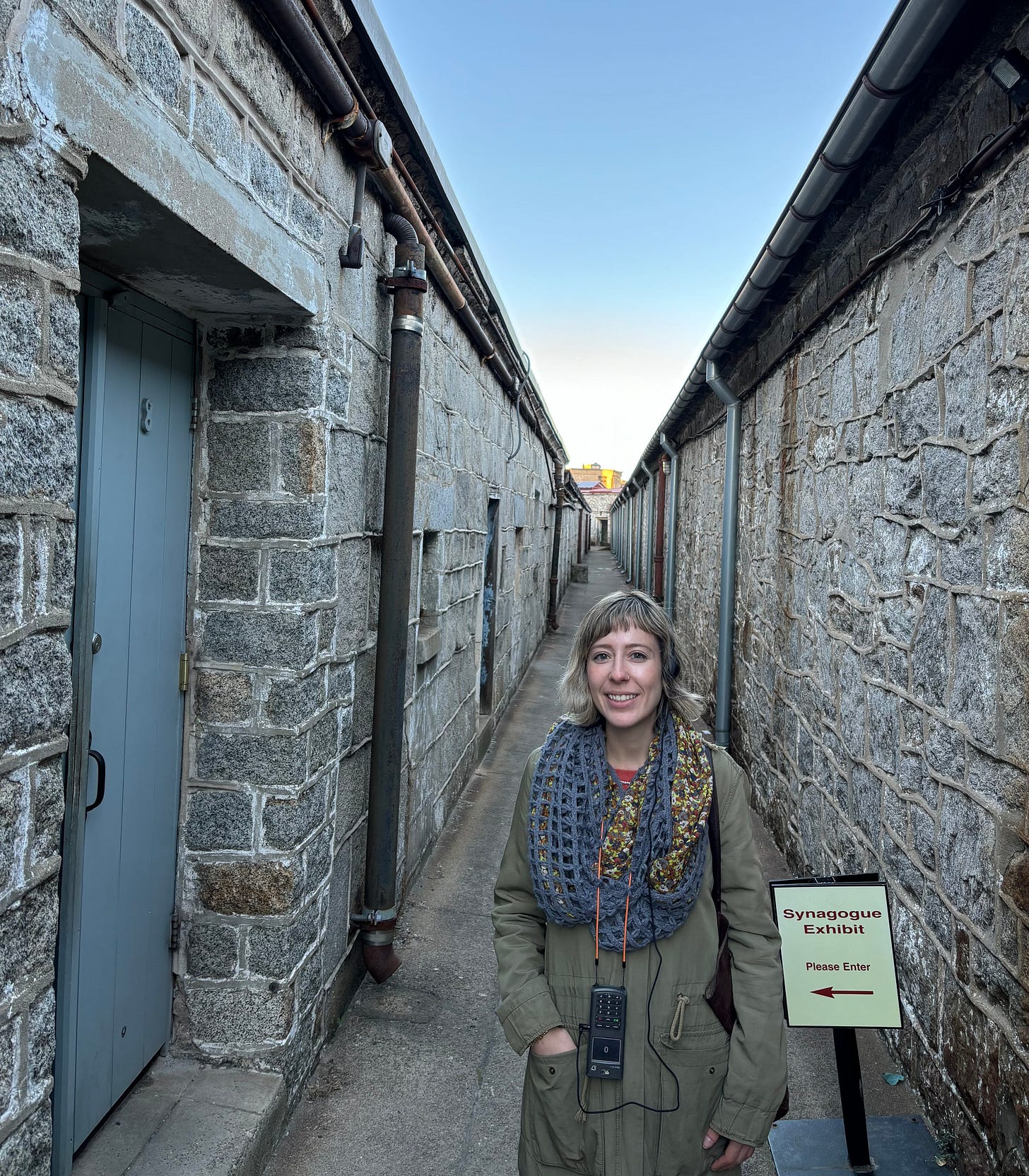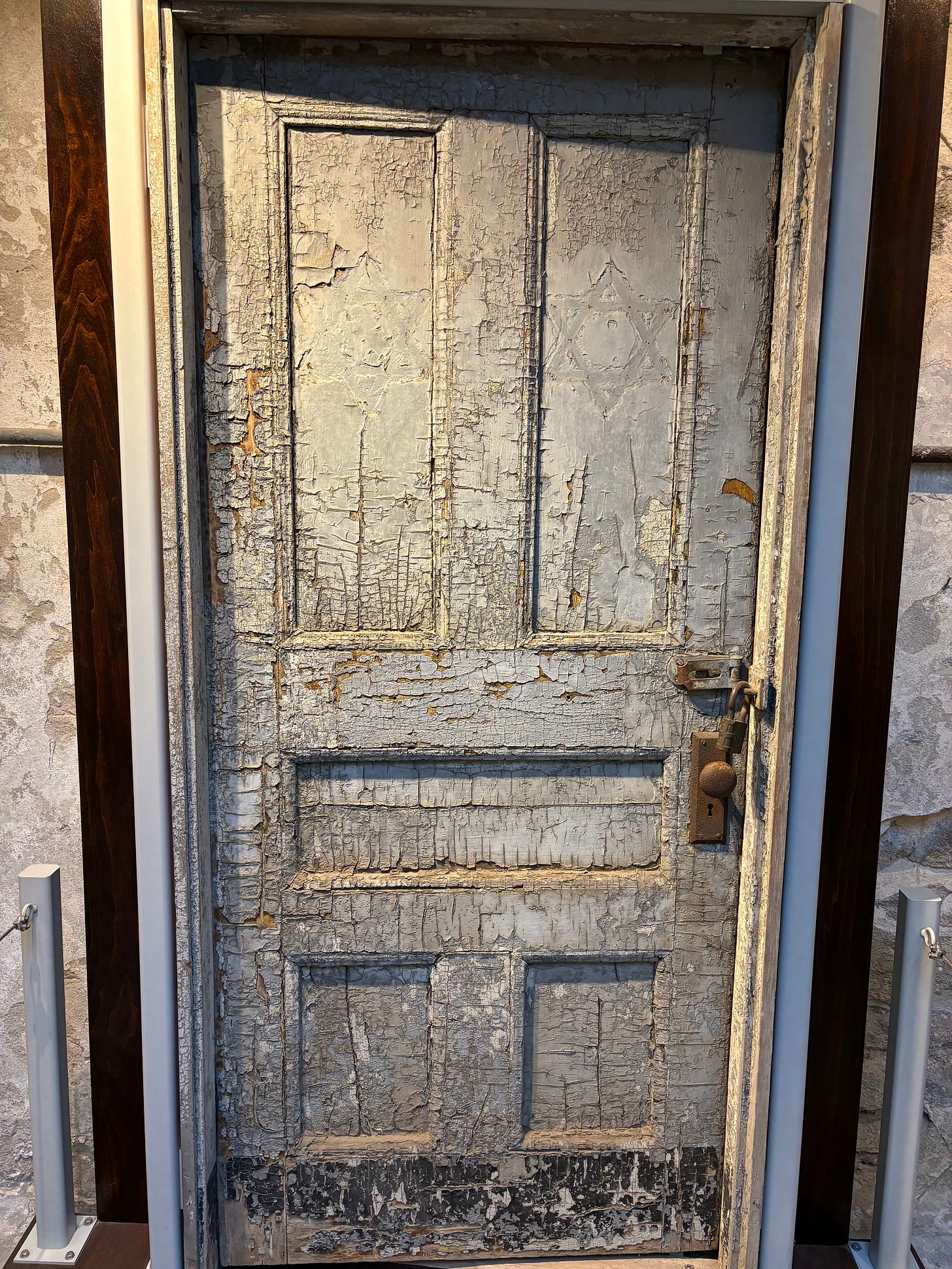A Rare Look Inside a Prison Synagogue
Come tour the synagogue museum of Philadelphia's Eastern State Penitentiary with me!
Shalom,
Last weekend, I went to Philadelphia for the first time since high school and had a bell of a time. 🔔
Of course I visited all the touristy sights: the Liberty Bell, Independence Hall, Zahav, or rather, pining after it since I couldn’t get a reservation ahead of time, etc.
I didn’t expect to see or do anything Jewish over the weekend, even though I desperately wanted to for Shabbat after last week’s ‘Jew hunt’ in Amsterdam. And admittedly, the Jewish history museum wasn’t high on my tourist bucket list, not when Benjamin Franklin’s house was calling my name.
But you know what they say… woman plans [to avoid Jewish plans] and G-d says, “Not today, sister.”
Because while on an audio tour of Eastern State Penitentiary, America’s first system of penitence via solitary confinement, led by actor Steve Buscemi himself (did you know it’s pronounced Bu-SEM-ee?!), I found G-d. Rather, I found a room in which to pray to G-d. A synagogue. I found a synagogue at a penitentiary!
Background
Eastern State was built in 1829 as the first of its kind: a prison designed around the radical idea of penitence. Instead of punishment, prisoners were kept in solitary confinement to encourage reflection and remorse in what was known as the "Pennsylvania System" or "separate system," where prisoners were kept in silence and in solitary confinement as a form of rehabilitation, as opposed to the “New York System” adopted at Sing Sing, where silent labor took the place of solitary.
Spoiler alert: solitary confinement didn’t work, as it was deemed harsh and had led to serious psychological effects on inmates. Starting in the 1870s, the penitentiary transitioned away from this system and by the turn of the century was more of a congregate system where prisoners could interact with each other.
Which brings us to…
The Synagogue
Tucked away in Cell Block 7 (anyone else want to belt out Chicago? Wrong city, I know, but that tango is catchy!) is a tiny synagogue with faded doors. I stumbled upon it while looking for Al Capone’s luxurious cell (Cicero, Lipschitz! 🎶 Okay, now the musical is appropriate).
I was amazed to learn that while there was no chapel or sanctuary built for inmates (multi-purpose rooms were used for this function), a synagogue was built for Jewish inmates in 1924.
But let’s back up; the congregation wasn’t built in a day!
Before there was a synagogue in the penitentiary, Jewish leaders in Philadelphia were concerned Jewish inmates would be pressured to convert to other faiths. Clergymen would visit inmates in their cells, with the first recorded visit by a Jewish clergyman in 1845.
In 1917, the first Shabbat services were held using a Torah ark built by inmates. Philadelphia leaders wanted to support Jewish inmates in the prison, and B’nai B’rith formed a Prison Aid Committee. That following year, the prison saw a Jewish chaplain and later received matzah for Passover Seders.
Philanthropists saw the need for a Jewish congregation and figured services and community would help acclimate them to post-prison life. In 1924, there were thirty Jewish inmates out of 1,398 inmates. The synagogue was built that year, the first of its kind in U.S. history.
By 1927, there were 42 Jews, an increase of nearly 50% in three years. The Jewish population and prison population were rapidly growing, along with Jews involved in organized crime, like Max “Boo Boo” Hoff, who recruited other Jews into organized crime activity like counterfeiting and gambling. He visited Al Capone while he was incarcerated at Eastern State in 1929.
Inside the Synagogue
The synagogue, a small room which was used from 1924-1970 and then renovated in 2009, had all the familiar fixin’s: a Torah ark, a ner tamid, a reading table, a ceiling adorned with a gold Star of David, and benches lining the walls.
It was discovered in the early 2000s in disrepair by severe weather damage, as you can see in the photos. There was a room in the back that served as a kosher kitchen.

Lastly, a small exhibit on Jewish life in the prison covered a lot of the information and history I just described. It concluded with the opportunity for visitors to submit their own mitzvah, offering a beacon of light amidst the shadow of a decayed prison.
In fact, the entire glimpse into Jewish life at the prison felt like a beacon of light. Prisons are inherently dark places, and Eastern State, with its bleak history, is no exception. Today, the U.S. prison system itself has one of the highest rates of incarceration in the world, imprisoning between 500 and 600 people for every 100,000 citizens. Its policies disproportionately impact Black Americans, who are incarcerated in state prisons at nearly five times the rate of white Americans. This stark disparity highlights the need for prison reform.
✍️Shabbat Prompt
What’s a good deed or act of kindness you’ve done this week? If you haven’t done one, what’s one you’d like to do? Try to do it this weekend or before Shabbat!
Shabbat Shalom,









Miranda, you’ve done it again! What a wonderful and fascination story!
I went to a challah bake !